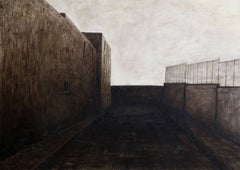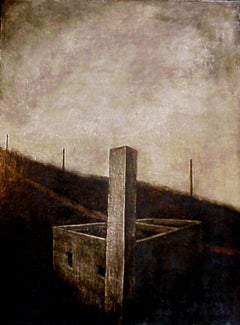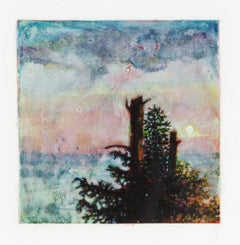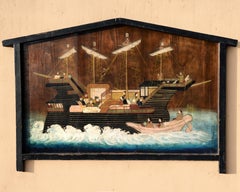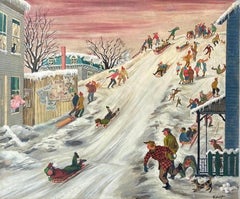Joan Nelson Art
to
5
2
1
2
2
1
1
2
1
1
Overall Height
to
Overall Width
to
4
1
2
2
1
1
1
1
1
1
1
1
5
3
2
5
6,952
3,302
2,514
1,213
4
3
3
2
2
Artist: Joan Nelson
"Untitled, " Joan Nelson, Modernist Trees and Clouds, Female Artist
By Joan Nelson
Located in New York, NY
Joan Nelson (American, b. 1958)
Untitled, 1990
Color lithograph
16 x 16 inches
From the edition of 45
Provenance:
Mary Ryan Gallery, New York, 1991
Reader's...
Category
1990s Modern Joan Nelson Art
Materials
Lithograph, Paper
Building Backyard, Painting by Joan Nelson
By Joan Nelson
Located in Long Island City, NY
This painting by Joan Nelson depicts a sepia-toned scene placed behind the walls of a dark brown building. Potentially depicting a rooftop or a balcony, a way further into the buildi...
Category
1980s Contemporary Joan Nelson Art
Materials
Masonite, Egg Tempera, Plaster
Untitled - Roof Top View, Painting by Joan Nelson
By Joan Nelson
Located in Long Island City, NY
This painting by Joan Nelson depicts a sepia-toned scene placed behind the walls of a dark brown building. Potentially depicting a rooftop, the nearly black ground is flanked on the left by tall, dark, and uniform buildings. Along the right is a cement wall topped by a chain link fence. The buildings and wall are both stopped in the distance by a dark border wall and above the whole scene is a foggy white sky.
Artist: Joan Nelson, American (1958 - )
Title: Roof Top View...
Category
1980s Contemporary Joan Nelson Art
Materials
Egg Tempera
Untitled
By Joan Nelson
Located in New York, NY
JOAN NELSON
UNTITLED, 1984
egg tempera on masonite
24 x 18 in. 61 x 45.7 cm.
signed and dated on verso
landscape
castle
Category
1980s Contemporary Joan Nelson Art
Materials
Masonite, Egg Tempera
Untitled
By Joan Nelson
Located in Palm Desert, CA
An acrylic ink and acrylic medium on paper landscape by Joan Nelson.
Provenance:
General Electric Corporate Collection;
Heather James Fine Art.
Category
1990s Contemporary Joan Nelson Art
Materials
Ink, Acrylic
Related Items
Large Japanese Wood Board Ema Namban Depicting a Portuguese Ship Edo period
Located in Stockholm, SE
An Ema is a votive plaque people hang in a "dedication area", at a Shinto shrine, with their wish to the gods. Wishes usually would revolve around health, love, career, prosperity, a...
Category
Mid-19th Century Realist Joan Nelson Art
Materials
Wood, Tempera, Egg Tempera, Wood Panel
Colliers Magazine 1947 American Scene Social Realism Modern Families in the Snow
Located in New York, NY
Colliers Magazine 1947 American Scene Social Realism Modern Families in the Snow
Katherine Wiggins (American 20th Century)
"The Shrimp"
20 x 24 inches
Egg tempera on masonite. c. 1...
Category
1940s American Realist Joan Nelson Art
Materials
Egg Tempera, Masonite
Pikes Peak, 1940s Colorado Mountain Landscape in Autumn, Tempera Painting
By Charles Ragland Bunnell
Located in Denver, CO
Original vintage 1941 Colorado landscape painting with autumn leaves and Pikes Peak blanketed in snow by Charles Bunnell (1897-1968). Inscribed verso, "To Laura, November 22, 1941", egg tempera on board. Signed by the artist in the lower left corner and titled verso. Presented in a custom frame, outer dimensions measure 15 ½ x 19 ¼ x 1 ¼ inches. Image size is 7 ¾ x 11 inches
About the Artist:
Artist and teacher, Charles ("Charlie") Bunnell worked in a variety of styles throughout his career because as an artist he believed, "I’ve got to paint a thousand different ways. I don’t paint any one way." At different times he did representational landscapes while concurrently involved with semi- or completely abstract imagery. He was one of a relatively small number of artists in Colorado successfully incorporating into their work the new trends emanating from New York and Europe after World War II. During his lifetime he generally did not attract a great deal of critical attention from museums, critics and academia. However, he personally experienced a highpoint in his career when Katherine Kuh, curator at the Art Institute of Chicago, personally chose one of his paintings - Why? - for its large exhibition of several hundred examples of abstract and surrealist art held in 1947-48, subsequently including it among the fifty pieces selected for a traveling show to ten other American museums.
An only child, Bunnell developed his love of art at a young age through frequent drawing and political cartooning. In high school he was interested in baseball and golf and also was the tennis champion for Westport High School in Kansas City. Following graduation, his father moved the family to Denver, Colorado, in 1916 for a better-paying bookkeeping job, before relocating the following year to Colorado Springs to work for local businessman, Edmond C. van Diest, President of the Western Public Service Company and the Colorado Concrete Company. Bunnell would spend almost all of his adult life in Colorado Springs.
In 1918 he enlisted in the United States Army, serving in the 62nd Infantry Regiment through the end of World War I. Returning home with a 10% disability, he joined the Zebulon Pike Post No. 1 of the Disabled American Veterans Association and in 1921 used the benefits from his disability to attend a class in commercial art design conducted under a government program in Colorado Springs. The following year he transferred to the Broadmoor Art Academy (founded in 1919) where he studied with William Potter and in 1923 with Birger Sandzén. Sandzén’s influence is reflected in Bunnell’s untitled Colorado landscape (1925) with a bright blue-rose palette.
For several years thereafter Bunnell worked independently until returning to the Broadmoor Art Academy to study in 1927-28 with Ernest Lawson, who previously taught at the Kansas City Art Institute where Bunnell himself later taught in the summers of 1929-1930 and in 1940-41. Lawson, a landscapist and colorist, was known for his early twentieth-century connection with "The Eight" in New York, a group of forward-looking painters including Robert Henri and John Sloan whose subject matter combined a modernist style with urban-based realism. Bunnell, who won first-place awards in Lawson’s landscapes classes at the Academy, was promoted to his assistant instructor for the figure classes in the 1928-29 winter term. Lawson, who painted in what New York critic James Huneker termed a "crushed jewel" technique, enjoyed additional recognition as a member of the Committee on Foreign Exhibits that helped organize the landmark New York Armory Exhibition in 1913 in which Lawson showed and which introduced European avant-garde art to the American public.
As noted in his 1964 interview for the Archives of American Art in Washington, DC, Bunnell learned the most about his teacher’s use of color by talking with him about it over Scotch as his assistant instructor. "Believe me," Bunnell later said, "[Ernie] knew color, one of the few Americans that did." His association with Lawson resulted in local scenes of Pikes Peak, Eleven Mile Canyon, the Gold Cycle Mine near Colorado City and other similar sites, employing built up pigments that allowed the surfaces of his canvases to shimmer with color and light. (Eleven Mile Canyon was shown in the annual juried show at the Carnegie Institute in Pittsburgh in 1928, an early recognition of his talent outside of Colorado.) At the same time, he animated his scenes of Colorado Springs locales by defining the image shapes with color and line as demonstrated in Contrasts (1929). Included in the Midwestern Artists’ Exhibition in Kansas City in 1929, it earned him the gold medal of the Kansas City Art Institute, auguring his career as a professional artist.
In the 1930s Bunnell used the oil, watercolor and lithography media to create a mini-genre of Colorado’s old mining towns and mills, subject matter spurned by many local artists at the time in favor of grand mountain scenery. In contrast to his earlier images, these newer ones - both daytime and nocturnal -- such as Blue Bird Mine essentially are form studies. The conical, square and rectangular shapes of the buildings and other structures are placed in the stark, undulating terrain of the mountains and valleys devoid of any vegetation or human presence. In the mid-1930s he also used the same approach in his monochromatic lithographs titled Evolution, Late Evening, K.C. (Kansas City) and The Mill, continuing it into the next decade with his oil painting, Pikes Peak (1942).
During the early 1930s he studied for a time with Boardman Robinson, director of the Broadmoor Art Academy and its successor institution, the Colorado Springs Fine Arts Center from 1930 to 1947. In 1934 Robinson gave him the mural commission under the Public Works of Art Project (PWAP) for West Junior High School in Colorado Springs, his first involvement in one of several New Deal art...
Category
1930s American Impressionist Joan Nelson Art
Materials
Egg Tempera, Board
H 15.5 in W 19.25 in D 1.25 in
Study for a Fish at Sea with Three Flags-Ink, egg-tempera and gold leaf on panel
By Konstantinos Papamichalopoulos
Located in Dallas, TX
Konstantinos Papamichalopoulos was born in Athens, Greece in 1975. He studied painting and printmaking at the Athens School of Fine Arts, where he also received a postgraduate degree...
Category
2010s Contemporary Joan Nelson Art
Materials
Gold Leaf
H 7.88 in W 15.75 in D 1.19 in
Eliyahu Boxer, Facets and Faces (triptych), acrylic & ink on canvas 60x150 cm
Located in Jerusalem, IL
Eliyahu Boxer
Facets and Faces (triptych), 2023
acrylic and ink on canvas
60 x 150 cm
24 x 59 in
Eliyahu was born in the United States and moved to Israel with his family at a ver...
Category
2010s Contemporary Joan Nelson Art
Materials
Canvas, Ink, Acrylic
Shaded Archway with Earth and Red - bold, colorful, abstract, acrylic on canvas
By Aron Hill
Located in Bloomfield, ON
Calgary’s Aron Hill creates unique, pop art Inspired by the dynamic form and colour of abstract artists like Jack Bush. This piece in acrylic and ink on canvas combines architectural...
Category
2010s Contemporary Joan Nelson Art
Materials
Canvas, Ink, Acrylic
Giant At Sea, Asian Inspired Painting with Samurai, Ink, egg-tempera, gold leaf
By Konstantinos Papamichalopoulos
Located in Dallas, TX
"Giant At Sea" is an Asian Inspired Painting with a colorful Samurai and sailing boats in the ocean, with lots of white waves. The piece is created using ink, egg-tempera, and a gold...
Category
2010s Contemporary Joan Nelson Art
Materials
Gold Leaf
H 25.2 in W 28.75 in D 1.19 in
Pink, Ink, egg tempera and gold leaf, illustrated architectural flower, nature
By Konstantinos Papamichalopoulos
Located in Dallas, TX
"Pink" is an enchanting creation by Konstantinos Papamichalopoulos, of an illustrated pink flower growing out of an architectural structure. The background is completely gold. It is ...
Category
2010s Contemporary Joan Nelson Art
Materials
Gold Leaf
H 9.45 in W 7.09 in D 1.19 in
Blue Flower in Tower, Ink, egg tempera and gold leaf, illustrated architectural
By Konstantinos Papamichalopoulos
Located in Dallas, TX
"Blue Flower in Tower" is an enchanting creation by Konstantinos Papamichalopoulos, of an illustrated, dancing blue flower growing out of an architectural structure. The background i...
Category
2010s Contemporary Joan Nelson Art
Materials
Gold Leaf
H 9.45 in W 7.09 in D 1.19 in
Colorado Gold Dredge, Breckenridge, Signed Black and White Mining Lithograph
By Arnold Rönnebeck
Located in Denver, CO
Lithograph on paper titled 'Colorado Gold Dredge, Breckenridge' by Arnold Ronnebeck (1885-1947) from 1932. Numbered 15/25. Depicted is a gold dredge in Colorado mining town Breckenridge with a mountain landscape in the background. Presented in a custom frame measuring 17 ¼ x 21 ¼ inches. Image size measures 10 ¼ x 14 ¼ inches.
Print is clean and in very good vintage condition - please contact us for a detailed condition report.
Provenance: Estate of Arnold Ronnebeck
Expedited and international shipping is available - please contact us for a quote.
About the Artist:
Modernist sculptor, lithographer and museum administrator, Rönnebeck was a noted member of European and American avant-garde circles in the early twentieth century before settling in Denver, Colorado, in 1926.
After studying architecture at the Royal Art School in Berlin for two years beginning in 1905, he moved to Paris in 1908 to study sculpture with Aristide Maillol and Émile-Antoine Bourdelle. While there he met and befriended American modernist painter, Marsden Hartley, of whom he sculpted a bronze head that was exhibited at the Salon d’Automne in Paris in 1912 and the following year at Hartley’s solo show of paintings at Alfred Stieglitz’s Gallery 291 in New York. A frequent guest of Gertrude Stein’s Saturday "evenings" in Paris, she described Rönnebeck as "charming and always invited to dinner," along with Pablo Picasso, Mabel Dodge (Luhan) and Charles Demuth.
After the outbreak of World War I in 1914, Rönnebeck returned to Germany where he served as an officer in the German Imperial Army on the front lines. Twice wounded, including in the Battle of Marne in France, Kaiser Wilhelm II awarded him the Iron Cross. During the war Hartley fell in love with Rönnebeck’s cousin, Lieutenant Karl von Freyburg, who was killed in combat. As a tribute to Freyburg, Hartley created Portrait of a German Officer (1914) now in the Metropolitan Museum of Art in New York.
After the war Rönnebeck traveled in Italy with German writer, Max Sidow, and German poet, Theodor Daubler, doing a series of drawings of Positano and the Amalfi Coast that formed the basis for his lithographs on the subject. The death of his finacée, the young American opera singer Alice Miriam in 1922 and his own family’s increasing financial problems in post-World War I Germany led him to immigrate to the United States in 1923. After living briefly with Miriam’s family in Washington, DC, he moved to New York where he became part of the avant-garde circle around Alfred Stieglitz. His essay, "Through the Eyes of a European Sculptor," appeared in the catalog for the Anderson Gallery exhibition, "Alfred Stieglitz Presents Seven Americans: 159 Paintings, Photographs & Things, Recent & Never Publicly Shown, by Arthur G. Dove, Marsden Hartley, John Marin, Charles Demuth, Paul Strand, Georgia O’Keeffe, Alfred Stieglitz."
In New York Rönnebeck began producing Precisionist-style lithographs of the city’s urban landscapes which he termed "living cubism." Some of them were reproduced in Vanity Fair magazine. Through Stieglitz he met Erhard Weyhe head of the Weyhe Gallery who, with its director Carl Zigrosser, arranged Rönnebeck’s first solo American exhibition in May 1925 at the gallery in New York. Comprising some sixty works – prints, drawings and sculpture – the show subsequently traveled on a thirteen-month tour of major American cities. Until the end of his life, the gallery represented him, along with other American artists Adolf Dehn, Wanda Gag, Rockwell Kent, J.J. Lankes, Louis Lozowick, Reginald Marsh and John Sloan.
In the summer of 1925, as the guest of Mabel Dodge Luhan, Rönnebeck first saw Taos, New Mexico, which Marsden Hartley had encouraged him to visit. It was there that he met his future wife, Louise Emerson, an easel painter and muralist. A year later they were married in New York before relocating to Denver. He served as director of the Denver Art Museum from 1926 to 1930 where he invited Marsden Hartley to lecture on Cézanne’s art in 1928. Rönnebeck fostered the development of the museum’s collection of American Indian art and the curation of modernist art exhibitions. In addition to his work at the museum, he was professor of sculpture at the University of Denver’s College of Fine and Applied Arts from 1929 to 1935, and wrote a weekly art column in the Rocky Mountain News.
His best known Denver sculptures from the late 1920s in bronze, copper, stone, wood and terra cotta include a reredos, The Epiphany, at St. Martin’s Chapel; The History of Money (six panels) at the Denver National Bank; The Ascension at the Church of Ascension; and the William V. Hodges Family Memorial at Fairmount Cemetery. At the same time he did a series of terra cotta relief panels for La Fonda Hotel in Santa Fe, New Mexico. In the 1930s his bas-relief aluminum friezes of stylized Pueblo and Hopi Indian Kachina masks...
Category
1930s American Modern Joan Nelson Art
Materials
Lithograph, Paper
H 17.25 in W 21.25 in D 0.75 in
Mexico
By Catherine Koenig
Located in Buffalo, NY
An original realist egg tempera painting by American artist Catherine Koenig created during her travels to Mexico. This work will be featured in the gallery's upcoming exhibition "Dr...
Category
21st Century and Contemporary Realist Joan Nelson Art
Materials
Egg Tempera, Board
Always Our Place, Original painting, Landscape art, River Wye, Hereford, Green
By Adele Riley
Located in Deddington, GB
Always Our Place, is a riverscape painting full of energy and movement, yet it exudes a feeling of harmony, peace and tranquility. The River in this painting is the river Wye near He...
Category
2010s Contemporary Joan Nelson Art
Materials
Canvas, Ink, Acrylic
H 21.66 in W 21.66 in D 1.97 in
Previously Available Items
Untitled
By Joan Nelson
Located in Palm Desert, CA
An acrylic ink and oil wax on paper landscape by Joan Nelson.
Provenance:
General Electric Corporate Collection;
Heather James Fine Art.
Category
1990s Contemporary Joan Nelson Art
Materials
Ink, Paper, Wax Crayon
Untitled #729
By Joan Nelson
Located in Los Angeles, CA
Category
Joan Nelson Art
Joan Nelson art for sale on 1stDibs.
Find a wide variety of authentic Joan Nelson art available for sale on 1stDibs. You can also browse by medium to find art by Joan Nelson in paint, egg tempera, tempera and more. Much of the original work by this artist or collective was created during the 20th century and is mostly associated with the contemporary style. Not every interior allows for large Joan Nelson art, so small editions measuring 3 inches across are available. Customers who are interested in this artist might also find the work of Herbert Kornfeld, Cobi Moules, and Eric Jon Holswade. Joan Nelson art prices can differ depending upon medium, time period and other attributes. On 1stDibs, the price for these items starts at $2,250 and tops out at $20,000, while the average work can sell for $14,000.
